To comply with my NDA, I have omitted and obfuscated all confidential information. The information below is my own and does not necessarily reflect the views of Box Inc.
Details
Box Inc
2018

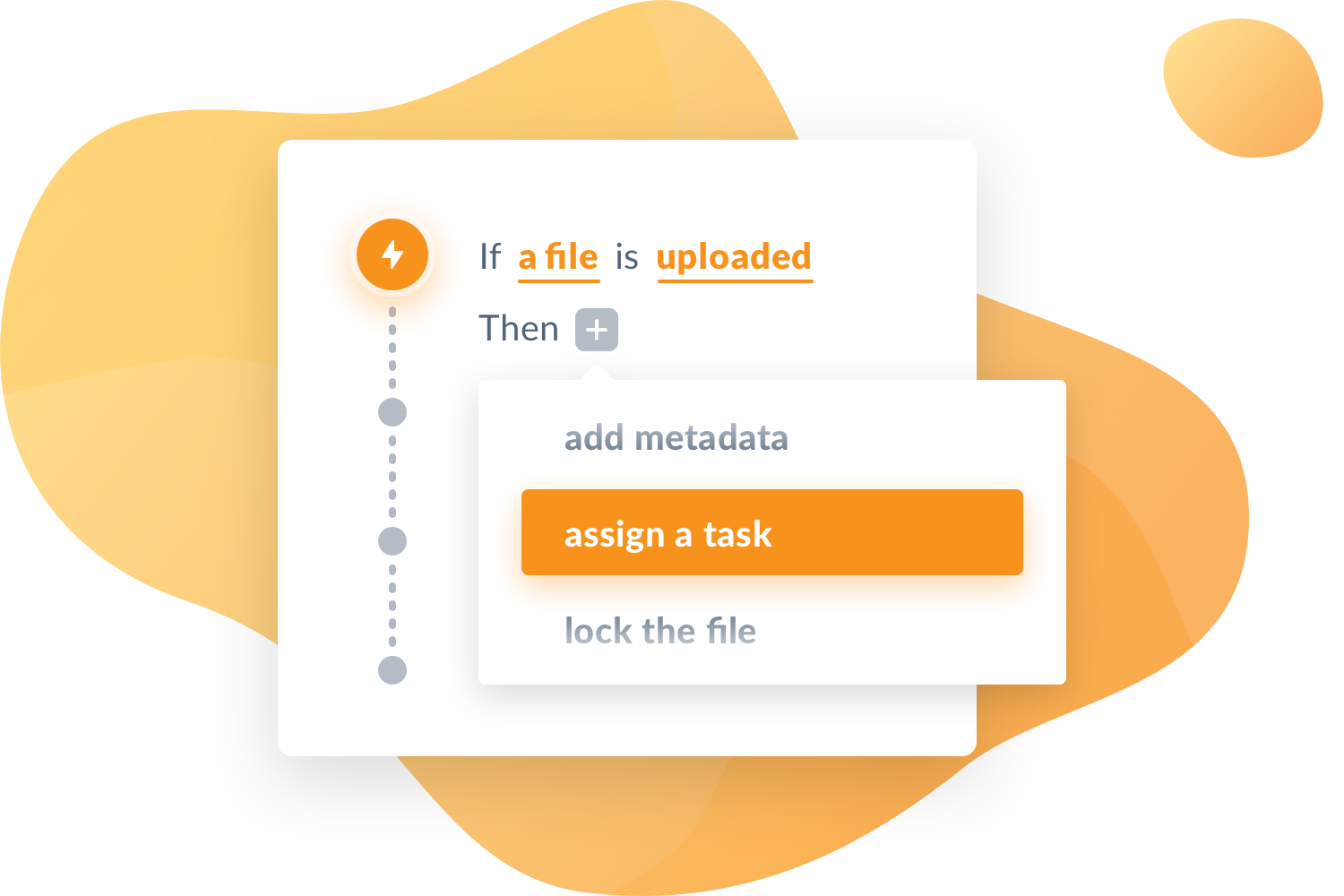
Automate Teamwork
Create rules to streamline everything you and your team does in Box. Automatically assign a task, add metadata, or set a file or folder action when content is updated.
Create Pro-Flows
Use metadata labels to filter incoming content and trigger the right process.
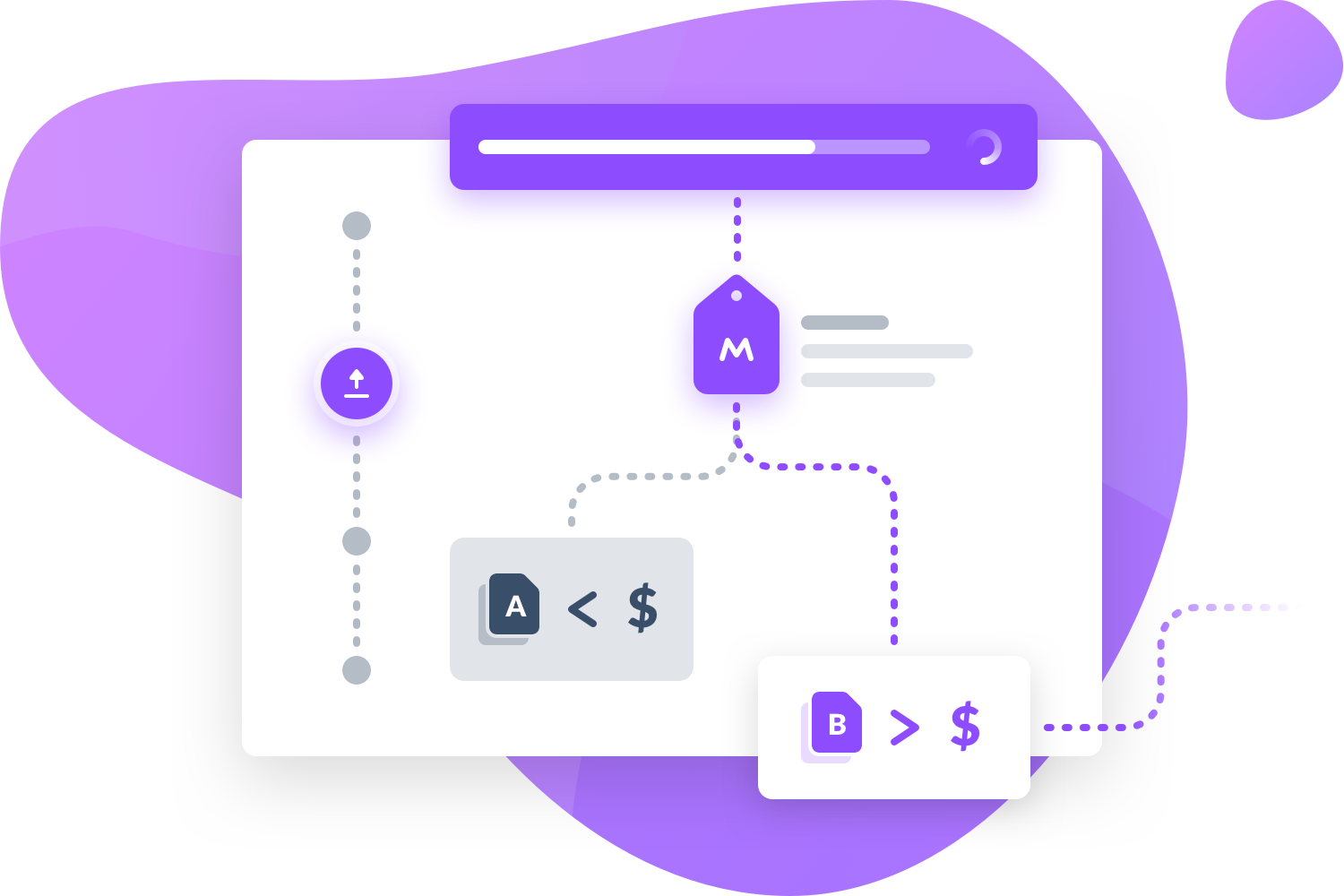
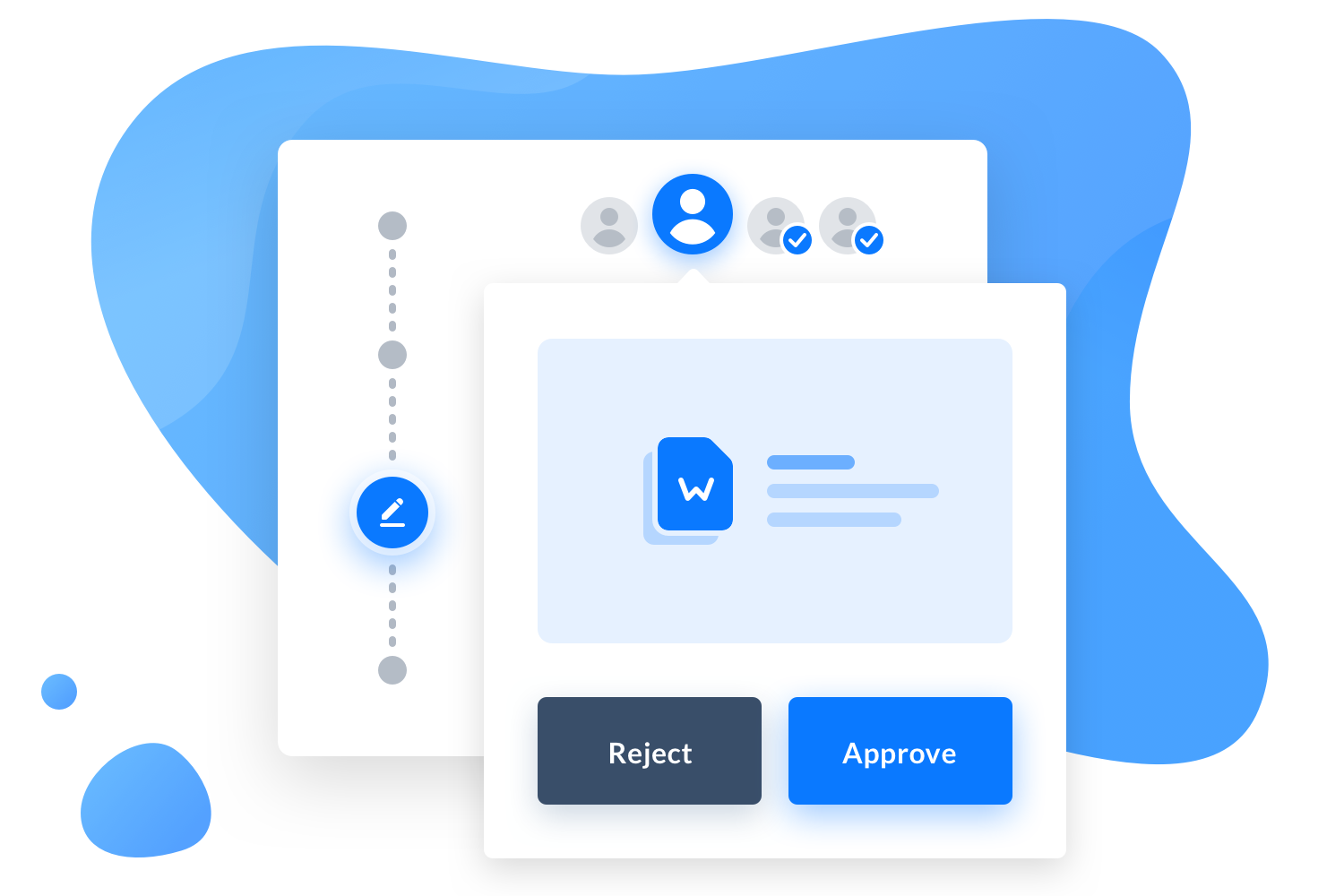
Assign Tasks
Program your review and approval processes by requiring any or all assignees to complete a task before moving to the next step.
Track Progress
Review who did what and when, and audit the status of your workflow if anything gets held up.
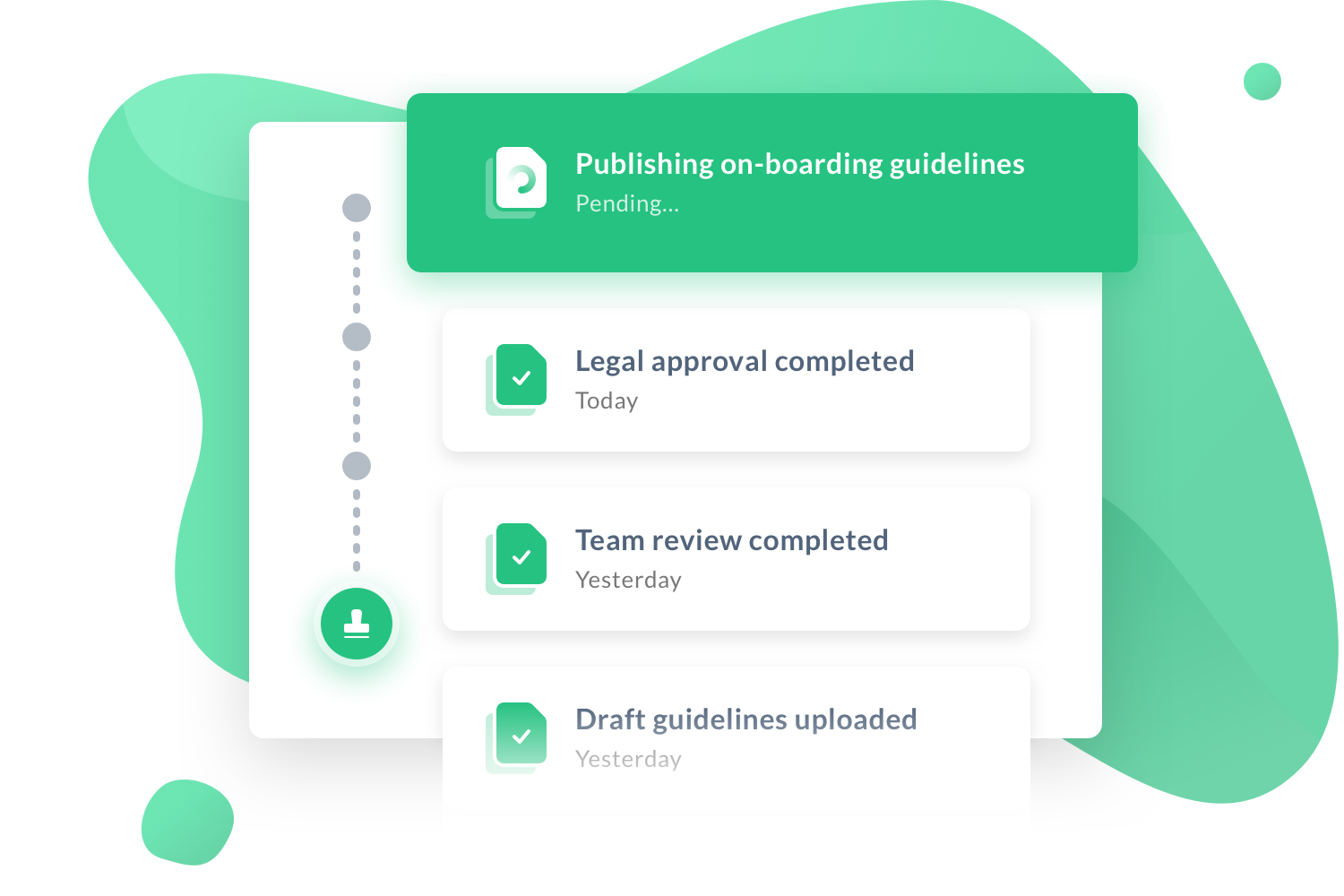
Orchestrate Your Team’s Process
Sales
Automate SOW/contract routing and approvals & expedite monthly forecasts.
Finance
Expedite invoice/AP processes & external audit reviews.
HR
Streamline employee onboarding & operating processes.
Legal
Streamline contract or policy reviews & approvals.
Marketing
Improve digital asset collaboration, content creation, and product releases.
Administration
Enforce data retention & other security/compliance policies.
Case Study
The Challenge
A holistic workflow solution
A workflow is a process that takes a piece of content from draft to final. Along the way, collaborators may edit, approve, sign, publish, secure a document, and more. Every team has a different order and complexity to their workflows, but they all share similar steps.
In 2018, Box had two separate workflow apps, Box Automations and Box Relay. As more users engaged with each product, we learned they needed the capabilities of both to holistically solve their use cases. In response, Box quadrupled its workflow investment to rearchitect Automations and fold Relay’s functionality into it.
Automations 1.0
Box Automations 1.0 helped users create simple rules to filter content into specific folders or assign a task whenever content was added to a folder.
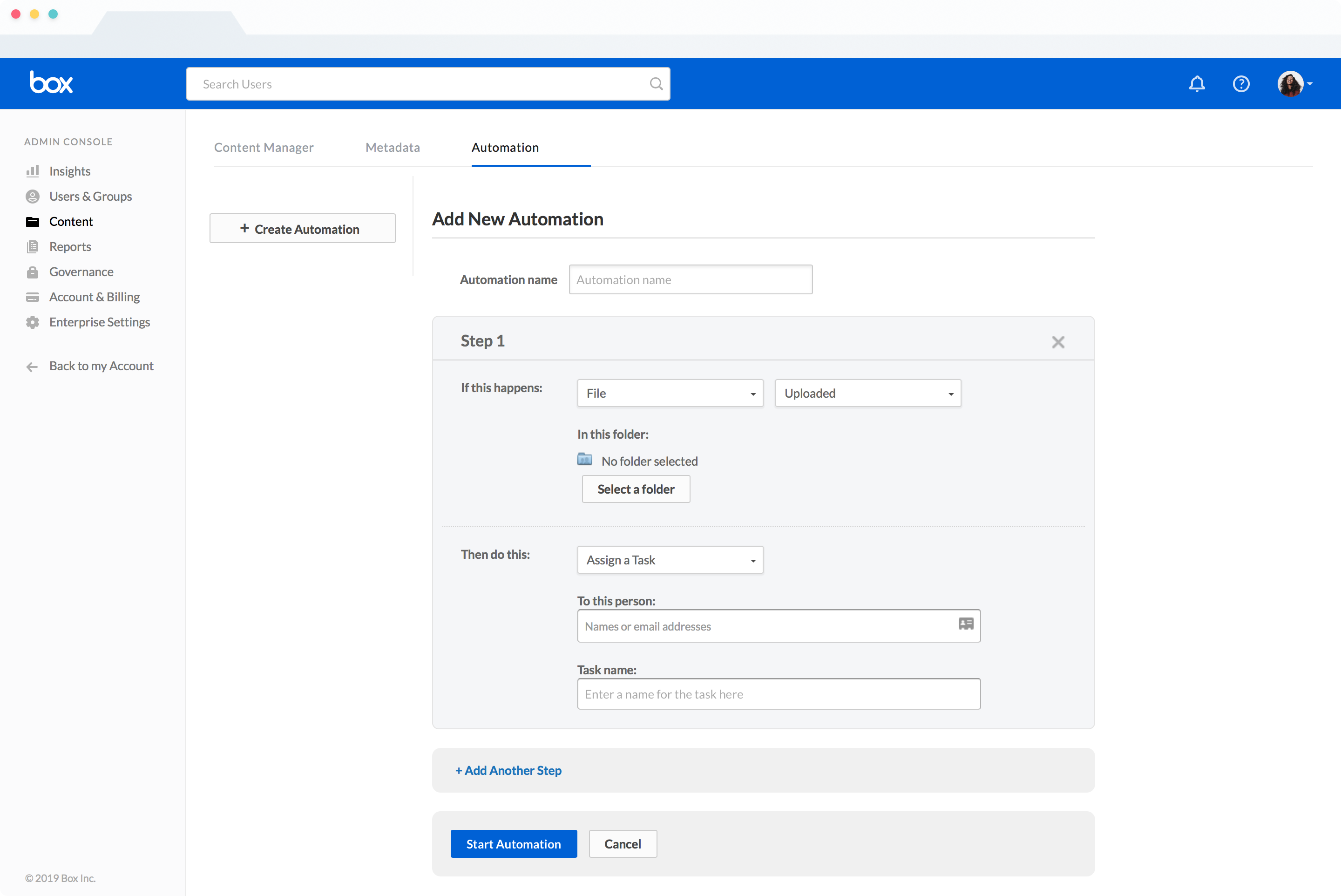
Relay
Box Relay was akin to Asana and helped teams complete standardized processes with a pre-defined task list, chat board, and progress tracker.
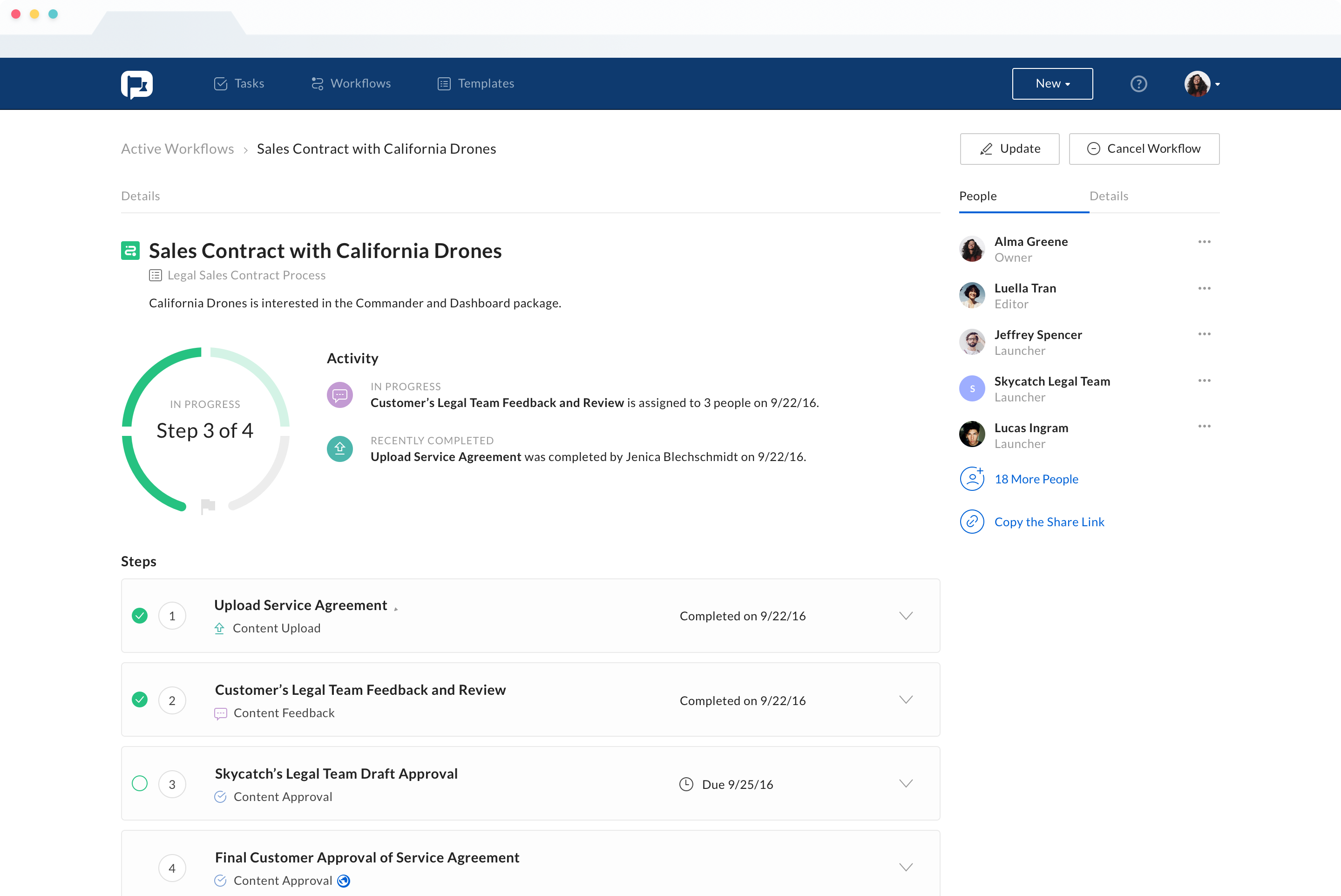
My Role
I led the user research & design of Automations from July 2018 – January 2019. My efforts included surveys, customer interviews, user testing, design strategy, and all visuals presented in this case study. Additionally, I worked alongside a VP of product, marketing strategist, and 8 incredibly talented engineers.
Discovery
Connecting with our users
I worked on Relay for 5 months before shifting focus to Automations. Over that time, my team learned what the product did well and where it needed to improve through marketing surveys,NPS, user studies, and customer interviews.
We partnered with strategic brands and synced with them monthly to stay current on their experience, and we borrowed the same research strategy for Automations.
User Segments
The users of Relay and Automations had overlapping needs. We merged the respective workflow personas, defined their canonical use cases, and identified must-have features.

Enterprise Admins
Admins and IT are responsible for all content and users across an enterprise. They are highly technical and familiar with workflow products.
Read more
Admins keep a close eye on teams working with sensitive content and implement processes for those teams to ensure content isn’t shared via email or printed for any reason.
Additionally, they are responsible for a budget and concerned with team process costs (resources and efficiency).
Needs
• Manage security & governance
• Author enterprise-wide workflows
• Manage user-created workflows
• Fix any issues
Impact
High Value
Segment size < 1%

Product Ops
Product operations create and enforce process on their respective teams. They set deadlines and remind team members when work needs to get done, and create team folder structures that map to the processes they manage.
Read more
Throughout a process, these content managers provide teams with templates, timelines, and wayfinding if special approval is required or if a 3rd party needs to be looped in.
They work hard to mitigate liability, enforce standards, and educate their teams on the required processes.
Needs
• Enforce standards
• Author workflows for teams
• Track workflow progress
• Communicate with team members
• Unblock their teams
Impact
High Value
Segment size = 5%

Content Creators
Content creators are individual contributors responsible for completing workflow steps (uploading content, reviews, approvals, etc). Their main concern is getting their work done well and on time.
Read more
Efficiency is always a challenge, because they are constantly changing context. Creators preview files in Box, edit them on their desktop, communicate with their team via email, print things out, scan them back in, and tracking their priorities on post-it notes.
Much of their process is manual and out of band, so their team doesn’t know what their status is and have difficulty managing their work when priorities surprise them.
Needs
• Understand requirements
• Prioritize their work
• Communicate with their team
• Track team progress
Impact
Low Value
Segment size > 90%
Competitors
We reviewed several workflow solutions and found them to be extremely powerful and complex. However, most were too technical and completely unusable for the average person managing a team’s business process.
The most notable competitors were MS Flow, IFTTT, & Zapier. These three products were no-code workflow builders that made it easy to author simple business processes and did an amazing job familiarising the “average person” to automations.
Competitive Landscape by degree of complexity
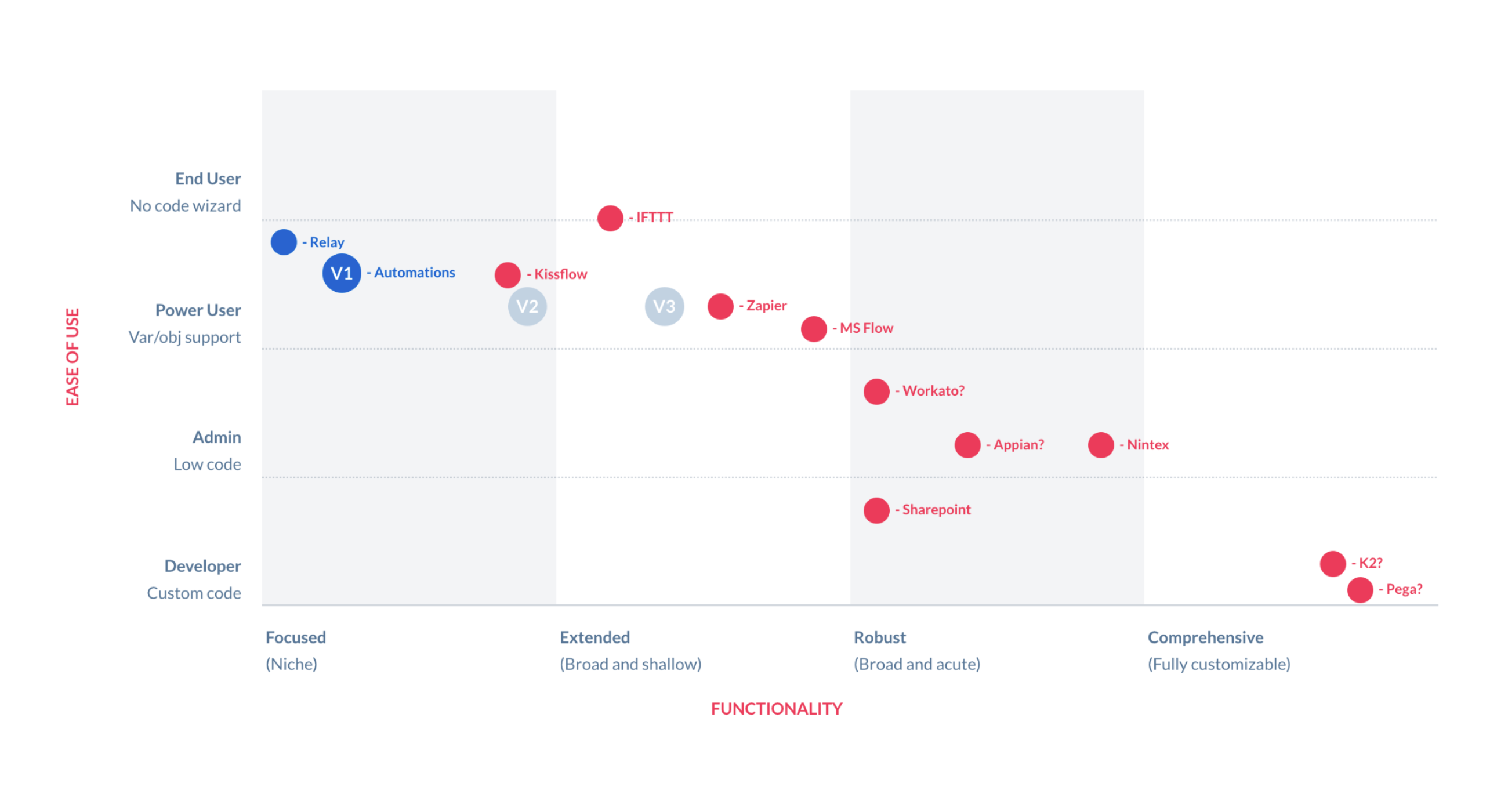
Design Strategy
Sanding off the edges
We demoed an initial concept at our yearly sales conference (Boxworks) and our customers gushed over the promise of the product. However, we quickly realized the concept demoed well, but was pretty tricky to learn without handholding. The experience needed an overhaul and I established three guiding principles based on customer feedback.
Built-in learning
Automations was to be democratized across every enterprise, but most users who store and share files in box never automated anything. Automations need to be familiar, easy to learn and easy to use thereafter.
Power user ready
6% of target users managed the processes of everyone else. Our goal was to keep friction to a mum and streamline the experience of the power user. It should only take a few minutes to author a process that saves hours of time.
Room to spare
Relay had a long roadmap and most of Box’s functionality was to be added to the menu of things users could automate. Our MVP needed to be extensible and ready for the prospective features of both products.
Styles & Layout
The home page of automations strictly used Box’s design language. However, the automations builder was based on our future 8dp column system, and customized styles and interactions to better support learning and creation.
Color Swatches
#222222
#0061D5
#A033F1
#F03454
#F7931D
#26C281
Illustrations & Iconography
Typography
Lato
Teams need a way to collaborate in real time, while also automating the manual work that's done every day. With Box Automations + Box Tasks, you get more from the processes that drive your business forward.
Responsive 8-Point Grid System
The Home Page
The home page of automations was designed with Box’s design language and intentionally austere. One page to view the status of in-progress automations, manage those you’ve authored, or start something new.
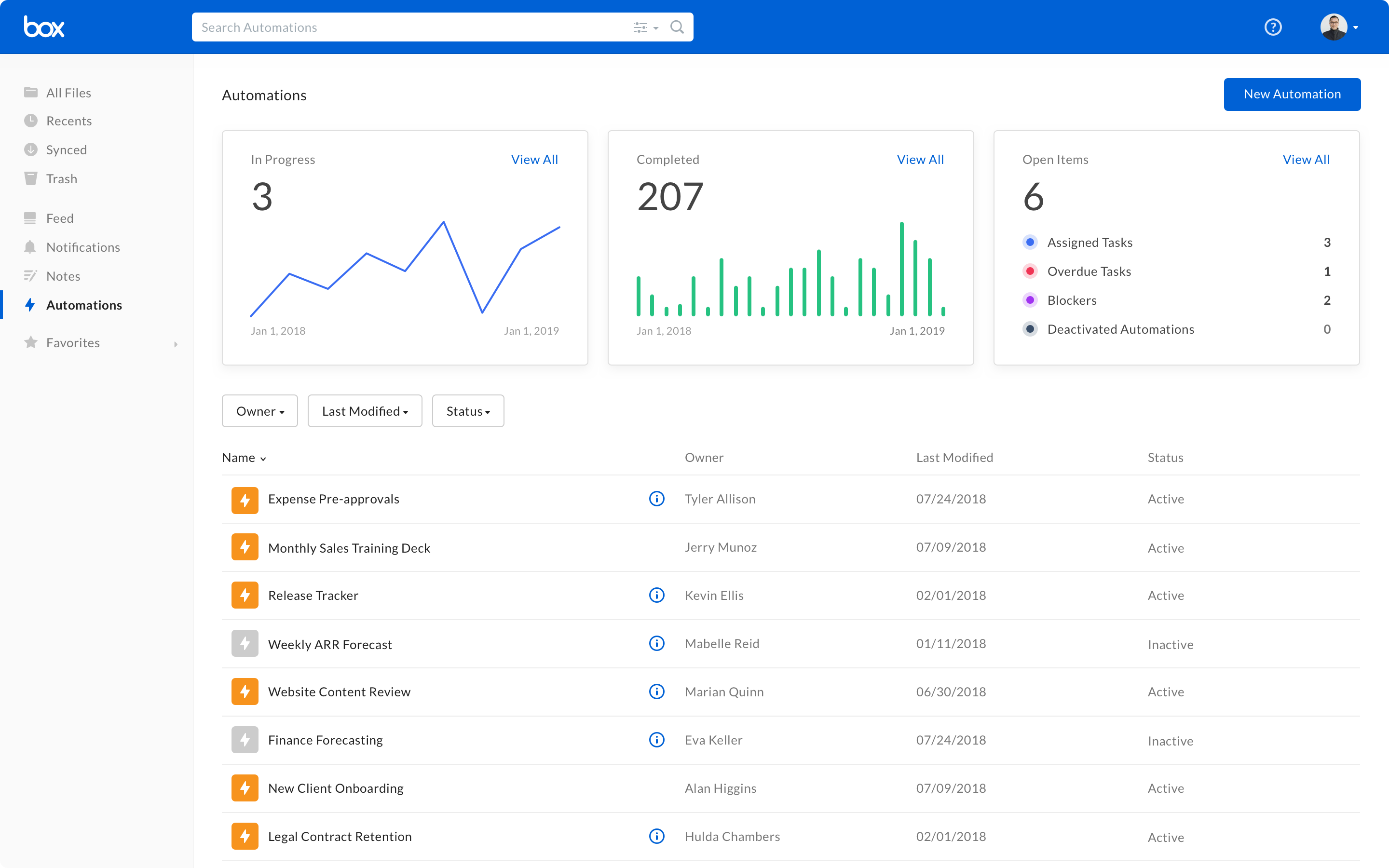
The Builder
It was tricky to design an automations builder that supported both technical IT admins and general users foreign to the concept. 99% of the people who had access to the feature would be novice users, but the remaining 1% would be responsible for authoring the majority of automations. We were cautious to over-index on one and neglect the other.
At its core, the automation builder is a form – like a survey, checkout process, or tax document. After studying many different interaction models, we explored three concepts.
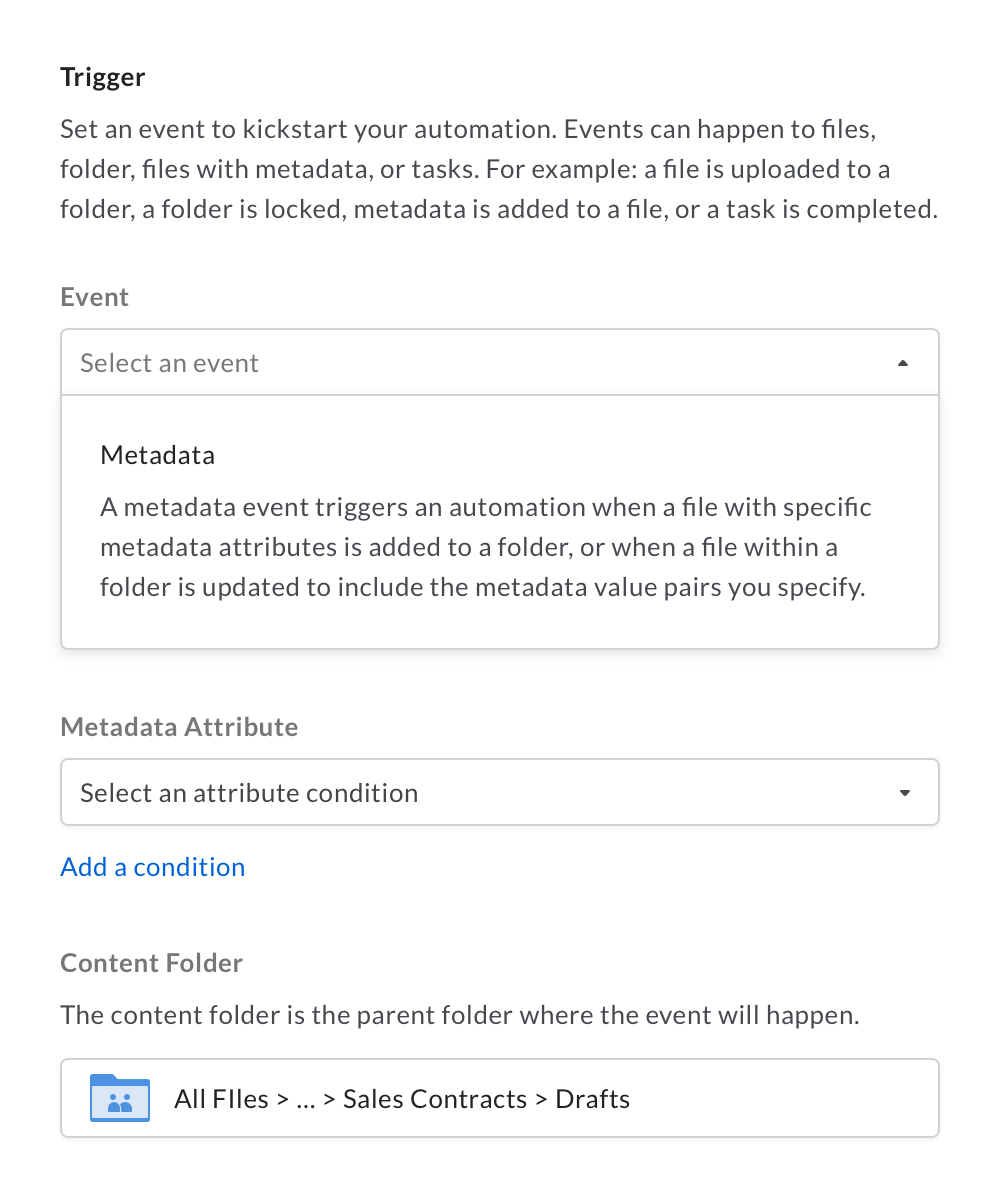
Option A
Traditional Form – 👎
The traditional form required a lot of instructional content to define the constructs and made the process feel heavy and complex.
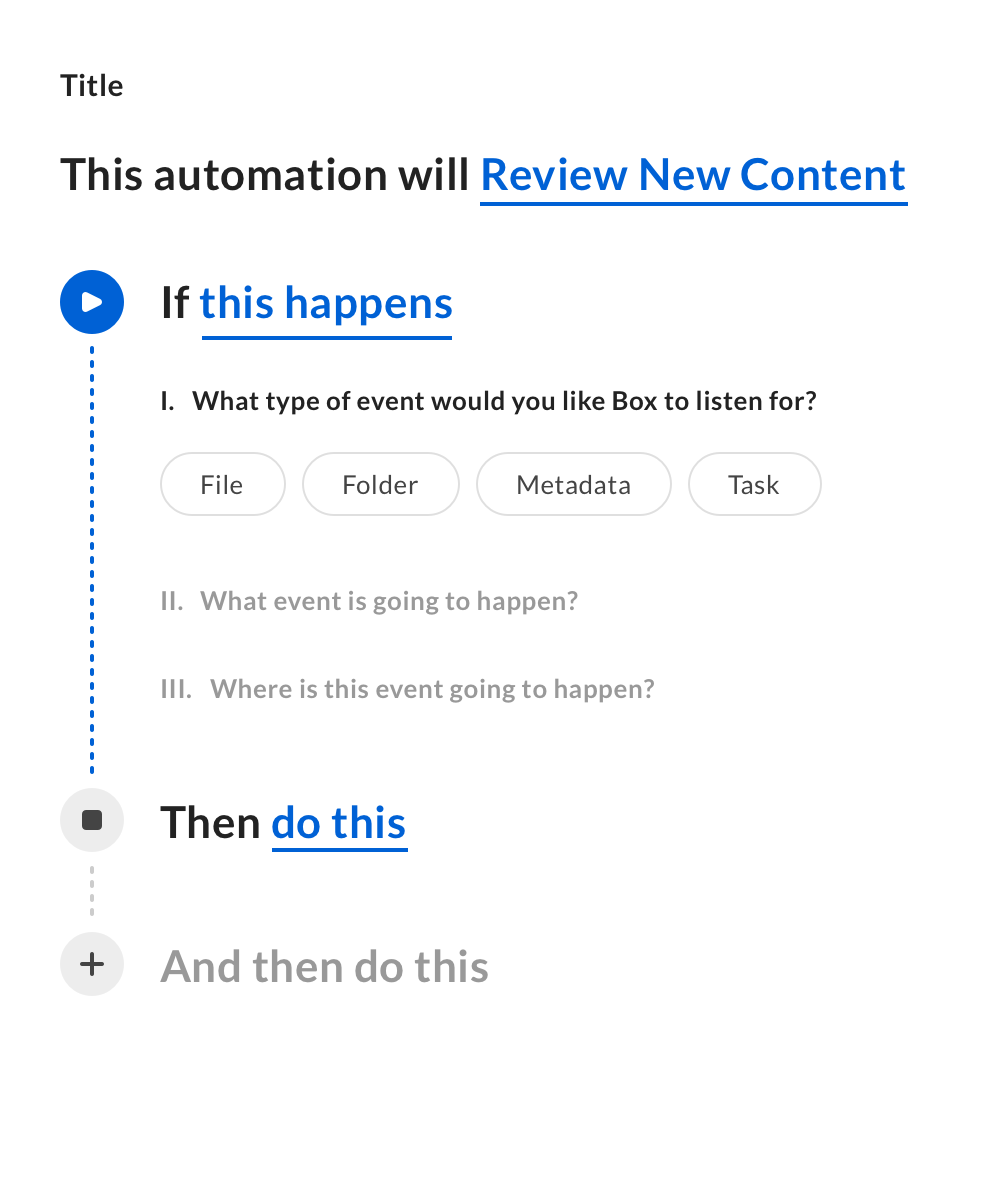
Option B
Natural Language Form – 👎
An “If This Then That” natural language builder was overly simplistic and couldn’t support all the settings each trigger and outcome required.
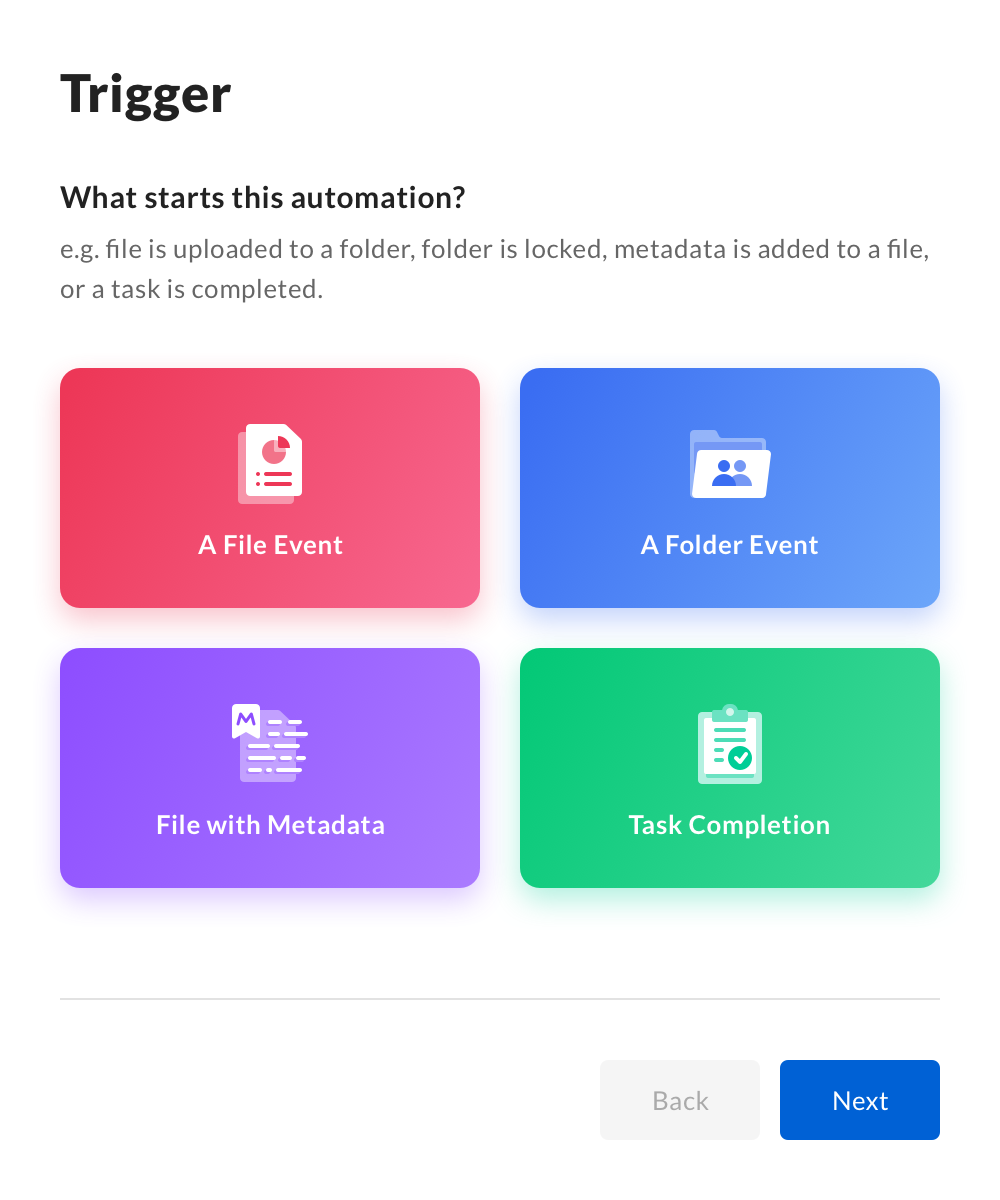
Option C
Turbo Tax Form – 🤙
A turbo tax inspired form relied on questions and responses, and abstracted the creation process just enough to help users quickly complete each step along the way.
The Fullscreen Wizard
The builder is a fullscreen experience. There was some debate to place it one level down in the Box web experience, but going fullscreen allowed us to do a few things:
1. Simplify the UI by removing the peripheral distraction of the web navigation.
2. Provide the real estate to add more in the future.
3. Customize Box design styles and interactions to better support learning and creation.
4. Create an automation directly from a file or folder in Box (like a modal).
Wizard Navigation
Our BoxWorks demo featured a “builder summary” on the on the right, like a shopping cart. However, users wanted to interact with this area, so we moved it to the left as a navigation element.
Additionally, we found users wanted to leverage it as a staging and organization area. So we allowed them to quickly add steps to outline their process and click-drag to sort it.
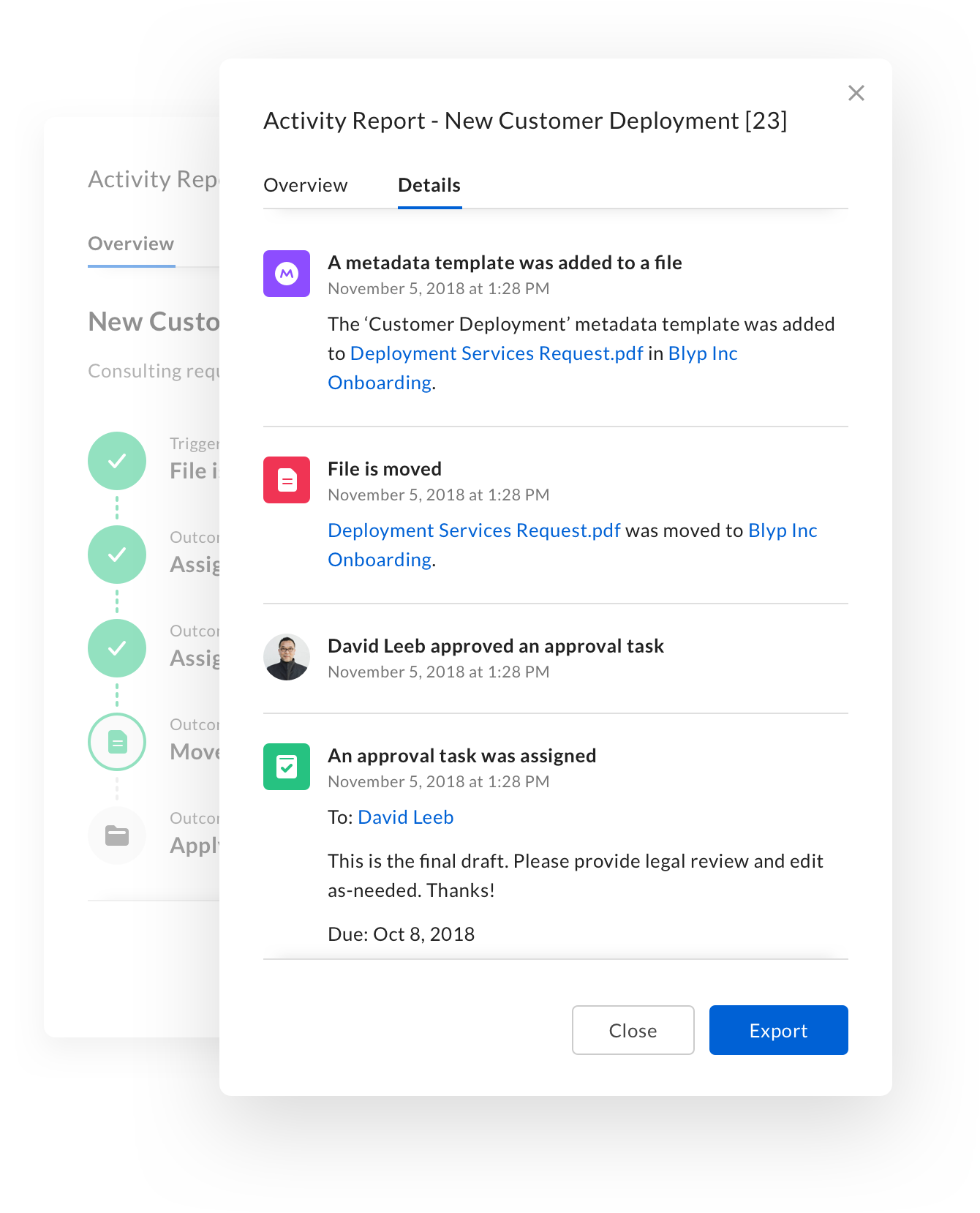
Tracking
Process owners needed a way to track and audit workflow executions. The home page displays a bird’s eye view of in-progress and completed automations, and users can click through to see how things are going.
Learning Aids
Although Box users were unfamiliar with any form of automation, the business hypothesized most would be interested in creating short processes for themselves (or their teams).
To support the hypothesis, we raised product awareness through a welcome experience and guided them with contextual learning aids.


End User Experience
For workflow participants, we built integrated cues to highlight when an automation acted as an agent on behalf of its author. This provided users with additional context when tasks were assigned, files relocated, folders locked, etc.
Execution
Keeping deliverables lean
The timeline of the project was faster than anything I’ve ever worked on and I didn’t have the luxury of finalizing designs before engineering began building. I was concerned important decisions would be made without my involvement, so I strategized with my team on how I could get ahead of their sprints and keep deliverables lean.
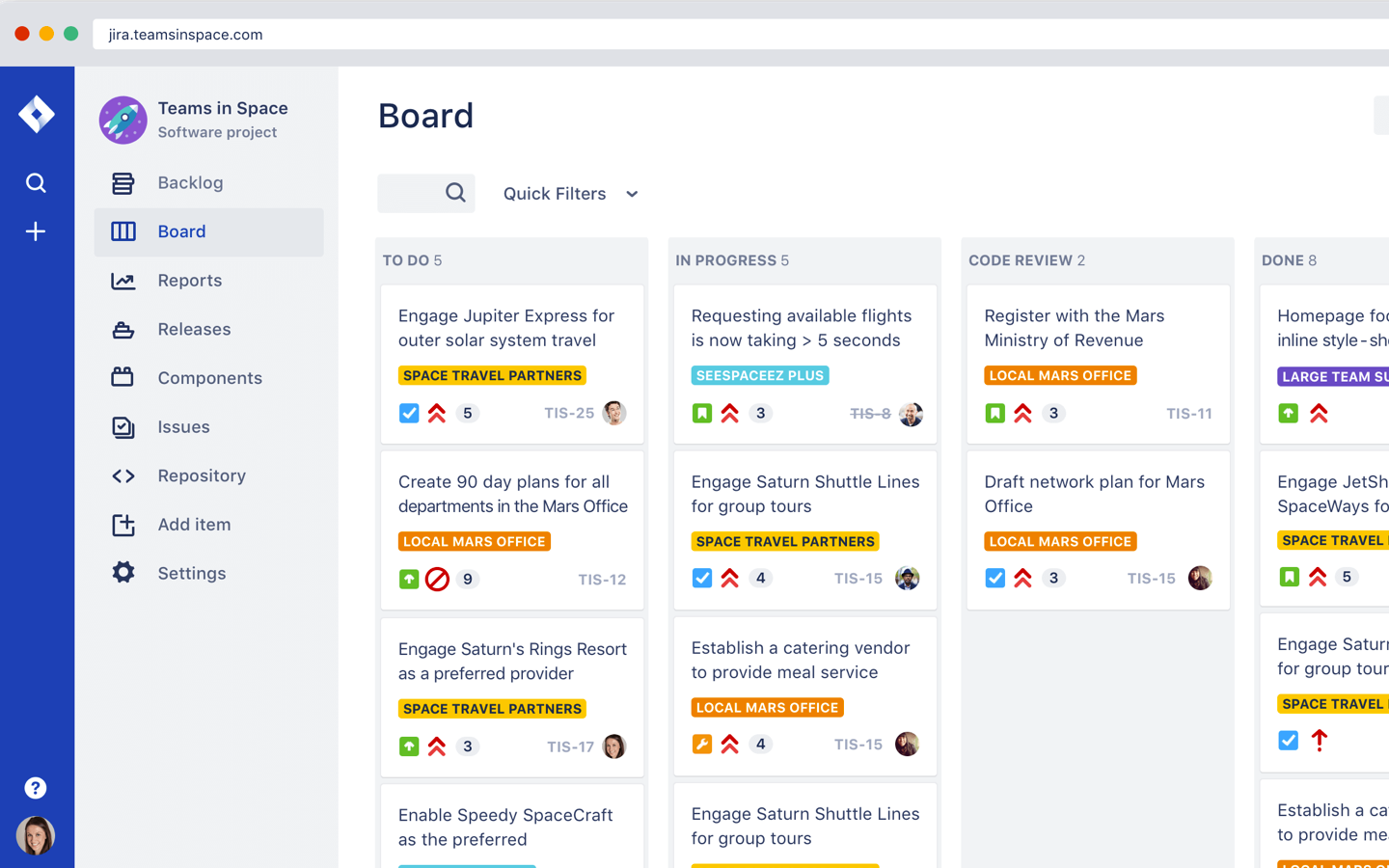
Design Backlog Grooming
To align with engineering, design dependencies were itemized and tracked in Jira. Every week we’d review the backlog to ensure I was prioritizing my efforts correctly, and push stories out if I needed clarity on requirements or time to research.

Gallery Saves The Day
Redlining designs, detailing interactive states, and authoring specification notes is incredibly time-consuming. I used Gallery.io to streamline this process and expedite our review cycles.

Principle > After Effects
What used to take days to animate with Adobe After Effects, only takes a few hours with Principle. Additionally, the Principle prototypes were leveraged in customer demos and user studies.
Retrospective
Progress over perfection
The biggest challenge my team faced was the tension between velocity and being thoughtful. The product manager had to play catchup with disruptive business decisions, engineering was directed to story map and scope unvalidated concepts, and I had to finalize and deliver core product elements days before engineering built them.
Thanks to an aggressive release date, conceptualizing a “complete experience” had to wait. So I put all my focus on laying a solid foundation and making the MVP easy to learn and easy to use thereafter. In the spirit of “velocity”, there were a few things I tried to ensure I was not a point of friction.
User research is never too little (or too late)
It’s easy to keep my head down and push pixels when a deadline is around the corner, but what good is it to deliver a bad product quickly?
Without dedicated user researchers, it was my responsibility to learn from our customers. Sharing concepts on customer calls, profiling user segments, and testing prototypes with internal folks that map to those profiles was as lean as it gets. To avoid a participant pool that was privy to our project, I sourced new hires from recruiting. It was accessible and extremely helpful.
Lose battles and build trust
My team had never worked together. Some of us were new to the problem and some were new to Box. Since we were moving fast, cohesion and trust were incredibly important to establish early. In pursuit of unity, I decided to democratize some of the tough decisions I had to make. This was a bit scary.
There were many ways I directed collaborative design decisions, but I found it best to provide a few options, have a strong opinion and hold it loosely. So long as the final decision didn’t make the product harder to use, I went with it (even if I disagreed).
Giving my team ownership and a voice into my work enabled them to provide me with meaningful critique, as well as good faith when I drew a hard line.
Putting my team first
Every time my priorities were reshuffled or increased in scope, it was easy to feel like my time wasn’t considered. In many instances, I would have been justified drawing hard boundaries and putting the burden on whoever was creating thrash. However, everyone on my team was experiencing high levels of stress. I chose to maintain my optimism and support them.
Serving my team by listening and having a solution-oriented mindset was the best way I knew how to lead them. Over time we reduced disruptions with honest discussions and better processes.